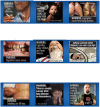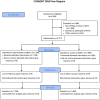Impact of tobacco-related health warning labels across socioeconomic, race and ethnic groups: results from a randomized web-based experiment
- PMID: 23341895
- PMCID: PMC3544861
- DOI: 10.1371/journal.pone.0052206
Impact of tobacco-related health warning labels across socioeconomic, race and ethnic groups: results from a randomized web-based experiment
Abstract
Background: The U.S. Family Smoking Prevention and Tobacco Control Act of 2009 requires updating of the existing text-only health warning labels on tobacco packaging with nine new warning statements accompanied by pictorial images. Survey and experimental research in the U.S. and other countries supports the effectiveness of pictorial health warning labels compared with text-only warnings for informing smokers about the risks of smoking and encouraging cessation. Yet very little research has examined differences in reactions to warning labels by race/ethnicity, education or income despite evidence that population subgroups may differ in their ability to process health information. The purpose of the present study was to evaluate the potential impact of pictorial warning labels compared with text-only labels among U.S. adult smokers from diverse racial/ethnic and socioeconomic subgroups.
Methods/findings: Participants were adult smokers recruited from two online research panels (n = 3,371) into a web-based experimental study to view either the new pictorial warnings or text-only warnings. Participants viewed the labels and reported their reactions. Adjusted regression models demonstrated significantly stronger reactions for the pictorial condition for each outcome salience (b = 0.62, p<.001); perceived impact (b = 0.44, p<.001); credibility (OR = 1.41, 95% CI = 1.22-1.62), and intention to quit (OR = 1.30, 95% CI = 1.10-1.53). No significant results were found for interactions between condition and race/ethnicity, education, or income. The only exception concerned the intention to quit outcome, where the condition-by-education interaction was nearly significant (p = 0.057).
Conclusions: Findings suggest that the greater impact of the pictorial warning label compared to the text-only warning is consistent across diverse racial/ethnic and socioeconomic populations. Given their great reach, pictorial health warning labels may be one of the few tobacco control policies that have the potential to reduce communication inequalities across groups. Policies that establish strong pictorial warning labels on tobacco packaging may be instrumental in reducing the toll of the tobacco epidemic, particularly within vulnerable communities.
Conflict of interest statement
Figures



References
-
- Family Smoking Prevention and Tobacco Control Act. Public Law No: 111–31 (2009)
-
- Food and Drug Administration Required Warnings for Cigarette Packages and Advertisements. 21 CFR Part 1141 (2011) - PubMed
-
- Institute of Medicine (2007) Ending the Tobacco Problem: A Blueprint for the Nation. Washington D.C.: The National Academies Press. 372 p.
-
- Hassan LM, Shiu E, Thrasher JF, Fong GT, Hastings G (2008) Exploring the effectiveness of cigarette warning labels: findings from the United States and United Kingdom arms of the International Tobacco Control (ITC) Four Country Survey. NVSM 13: 263–274.
Publication types
MeSH terms
LinkOut - more resources
Full Text Sources
Other Literature Sources

